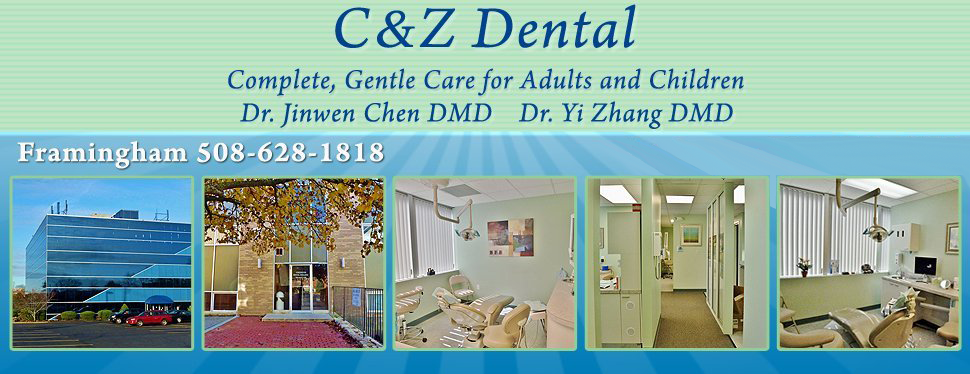Family Dentist In Framingham, MA
C&Z Dental
Routine Dental Exam and Cleaning
Routine dental exams and cleanings not only catch common diseases such as periodontal disease, and dental decay early (saving you time, pain and money in the long run); but can also find early oral symptoms of more serious problems such as sinus infections, TMJ disorder, and oral cancer. After your exam, we will make a treatment plan. We will discuss the treatment plane with you to make sure that you understand what you oral condition and what the treatment is for.
Sealing and Fluoride
Dental sealants are thin plastic coatings that are applied to grooves on the chewing surfaces of the back teeth to protect them from tooth decay. Sealants protect these surfaces from tooth decay by keeping germs and food particles out of the grooves and pits of your teeth. Permanent molars are most likely to benefit from sealants. Molars usually first show up in a child’s mouth around age 6. Additional molars appear around age 12. It is best if the sealant is applied soon after teeth have emerged, before they have a chance to decay. Applying sealants does not require drilling or removing tooth structure and the process is short and easy.

Topical fluoride is probably the most important source of prevention of tooth decay. Topical fluoride inhibits the metabolism of the decay-producing bacteria in plaque and stabilizes minerals in the teeth, thus preventing or slowing down the caries process. Topical fluoride can also aid in the remineralization of tooth surfaces
Filling/Restorative
Structural tooth defects caused by decay or trauma will require "filling".
Silver mercury amalgam fillings have been used safely in dentistry for over 150 years. When mercury is combined with silver and other materials for dental fillings, its chemical nature is changed so that it is essentially harmless. The exposure to mercury from silver fillings is less than what patients are exposed to in food, air, and water on a daily basis. Scientific data supports the continued use of silver amalgam as a widely used filling material.
Tooth-colored fillings (composite fillings) are made from durable plastics called composite resins. The biggest advantage of tooth-colored filling is a more aesthetic appearance. Tooth-colored filling is also tooth structure-conservative. Because it depends on bonding forces rather than mechanical retention, less healthy tooth structure needs to be removed to prepare the tooth for a filling. Compared to silver fillings, tooth-colored fillings require more steps and take longer to fill. In addition, they are more costly than silver fillings. Therefore, some insurance companies only allow allocate benefits for silver fillings.
Crowns
When a large portions of the tooth structure is missing, a crown is often used to restore the tooth. Crowns are also used to attach bridges, cover implants, or to prevent a cracked tooth, root canal treated tooth from becoming worse.
Types of crowns include the full porcelain crown (ideal for use on the front teeth), the porcelain-fused-to-metal crown and the all-metal crown (ideal for use on the back teeth).
Root Canal Treatment (RCT)
At the center of your tooth is pulp, which is a collection of blood vessels that helps rebuild the surrounding tooth. Infection of the pulp can be caused by trauma, deep decay, cracks and chips. Symptoms of pulp infection include sensitivity to temperature, tooth pain, visible injury, or swelling of the gum. If you experience any of the aforementioned symptoms, we will most likely recommend non-surgical treatment to eliminate the diseased pulp. In root canal treatment, (RCT), the infected pulp is removed and the root canal system is thoroughly cleaned and sealed. RCT usually involves local anesthesia and may be completed in one or more visits depending on the treatment required. RCT success rate is around 90%. If your tooth is not amenable to RCT or if the chance of success is unfavorable, you will be informed at the time of consultation or when a complication becomes evident during or after treatment. Because RCT only involves local anesthesia, you will be able to drive home after your treatment, will probably be comfortable returning to your normal daily routine.
Extraction/Wisdom Teeth Extraction
Some teeth are extracted because they are severely decayed/injured, have advanced periodontal disease, or are in preparation for orthodontic treatment.
Wisdom teeth are the third and final set of molars that most people get in their late teens or early twenties. Sometimes these teeth can be a valuable asset to the mouth when healthy and properly aligned. However, more often than not, they are misaligned or impacted and require removal.
Bridge
A bridge is a device used to replace missing teeth. It attaches artificial teeth to adjacent natural teeth, called abutment teeth. The bridges are applied by either placing crowns on the abutment teeth or by bonding the artificial teeth directly to the abutment teeth.
Dentures
Removable partial dentures are used to replace missing teeth. They are attached to the teeth with metal clasps or by precision attachments and can removed and taken out for cleaning.
A complete denture , often called an appliance, replaces all missing teeth and provides support for the cheeks and lips.
A conventional denture is made after all teeth have been extracted and the tissues (gums) have healed.
An immediate denture is fabricated and inserted immediately after the teeth are extracted and tissue is allowed to heal under the denture.
Get the quality dental care you want for the whole family.
To schedule your FREE consultation, call our Framingham office at
508-628-1818.

